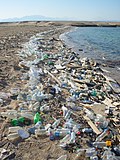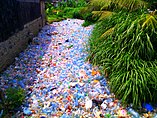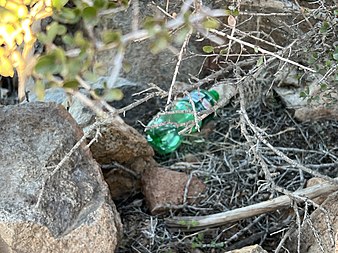**Plastic Pollution Statistics**:
– Estimates suggest over 1 billion tons of plastic waste discarded since the 1950s.
– Global production of 8.3 billion tons of plastic, with only 9% recycled.
– In 2018, 343 million tons of plastic waste generated, 90% post-consumer waste.
– Plastic packaging makes up a large proportion of post-consumer plastic waste.
– Difficulty in quantifying sources and amounts of plastic leakage into the environment.
– Global plastic production surged from 1.5 million tons in the 1950s to 335 million tons in 2016.
– 79% of plastic products inefficiently treated, leading to environmental release.
– Only 9% of produced plastic recycled, 12% incinerated.
– 368 million tons of plastic produced annually, with Asia producing 51%.
– Global mass of produced plastic exceeds biomass of all land and marine animals combined.
– 9.2 billion tonnes of plastic produced between 1950-2017, with more than half produced since 2004.
– Less than 10% of plastic is recycled, and only 14% is incinerated.
**Types of Plastic Debris**:
– Three major forms of plastic contributing to pollution: micro-, macro-, and mega-plastics.
– Mega- and micro-plastics accumulate in high densities in the Northern Hemisphere.
– Plastic found off the coast of islands due to currents carrying debris.
– Mega- and macro-plastics commonly found in packaging, footwear, and domestic items.
– Microdebris includes plastic pieces between 2mm and 5mm in size, commonly known as nurdles.
– Macrodebris includes items larger than 20mm like plastic bags, with fishing nets being a significant pollutant.
**Impacts of Plastic Pollution**:
– Plastic pollution affects both land and marine ecosystems.
– Living organisms, especially marine animals, are harmed by plastic ingestion and entanglement.
– Bodies of 90% of seabirds contain plastic debris.
– By 2050, there may be more plastic than fish in the oceans by weight.
– Plastic waste disrupts hormonal mechanisms in organisms.
– Plastic pollution negatively impacts marine habitats and coastal areas.
– Plastic pollution causes ecological effects, affecting biodiversity and trophic relationships.
**Global Plastic Waste Management and International Efforts**:
– Basel Convention amendment regulates export/import of plastic waste.
– 175 countries pledged to create a binding agreement to end plastic pollution by 2024.
– Efforts to reduce free-range plastic pollution through cleanup and recycling.
– Increased plastic waste production during the COVID-19 pandemic.
– Plastic industry exploiting health concerns to increase single-use plastic production.
– Efforts by major companies to reduce plastic consumption and increase recycling.
– International treaties signed by 187 countries in 2019 restricted the export of plastics for recycling.
**Environmental and Health Effects of Plastic Pollution**:
– Plastic pollution exacerbates climate change by releasing greenhouse gases.
– Plastic tap water pollution’s impact on human health and ecosystems requires further research.
– Plastic pollution on land poses a threat to plants and animals.
– Plastic waste can clog storm drains, increasing flood damage, especially in urban areas.
– Microplastic pollution has significantly increased due to poor plastic handling and disposal.
– Microplastics are extensively found in soil, affecting plants and animals.
– Effluent and sludge from wastewater contain large amounts of plastics.
Plastic pollution is the accumulation of plastic objects and particles (e.g. plastic bottles, bags and microbeads) in the Earth's environment that adversely affects humans, wildlife and their habitat. Plastics that act as pollutants are categorized by size into micro-, meso-, or macro debris. Plastics are inexpensive and durable, making them very adaptable for different uses; as a result, manufacturers choose to use plastic over other materials. However, the chemical structure of most plastics renders them resistant to many natural processes of degradation and as a result they are slow to degrade. Together, these two factors allow large volumes of plastic to enter the environment as mismanaged waste which persists in the ecosystem and travels throughout food webs.
- Olive ridley sea turtle entangled in a ghost net in the Maldives
- Plastic pollution of Sharm el-Naga beach, near Safaga, Egypt
- Piles of plastic waste on the government-authorized "garbage island" of Thilafushi, Maldives
- Canada Dry plastic bottle on hiking trail in the United States adjacent to an urban hiking trail.
- A tributary of the Wouri River in Douala, Cameroon, completely clogged with plastic.
Plastic pollution can afflict land, waterways and oceans. It is estimated that 1.1 to 8.8 million tonnes of plastic waste enters the ocean from coastal communities each year. It is estimated that there is a stock of 86 million tons of plastic marine debris in the worldwide ocean as of the end of 2013, with an assumption that 1.4% of global plastics produced from 1950 to 2013 has entered the ocean and has accumulated there.
Global plastic production has surged from 1.5 million tons in the 1950s to 335 million tons in 2016, resulting in environmental concerns. A significant issue arises from the inefficient treatment of 79% of plastic products, leading to their release into landfills or natural environments.
Some researchers suggest that by 2050 there could be more plastic than fish in the oceans by weight. Living organisms, particularly marine animals, can be harmed either by mechanical effects such as entanglement in plastic objects, problems related to ingestion of plastic waste, or through exposure to chemicals within plastics that interfere with their physiology. Degraded plastic waste can directly affect humans through direct consumption (i.e. in tap water), indirect consumption (by eating plants and animals), and disruption of various hormonal mechanisms.
As of 2019, 368 million tonnes of plastic is produced each year; 51% in Asia, where China is the world's largest producer. From the 1950s up to 2018, an estimated 6.3 billion tonnes of plastic has been produced worldwide, of which an estimated 9% has been recycled and another 12% has been incinerated. This large amount of plastic waste enters the environment and causes problems throughout the ecosystem; for example, studies suggest that the bodies of 90% of seabirds contain plastic debris. In some areas there have been significant efforts to reduce the prominence of free range plastic pollution, through reducing plastic consumption, litter cleanup, and promoting plastic recycling.
As of 2020, the global mass of produced plastic exceeds the biomass of all land and marine animals combined. A May 2019 amendment to the Basel Convention regulates the exportation/importation of plastic waste, largely intended to prevent the shipping of plastic waste from developed countries to developing countries. Nearly all countries have joined this agreement. On 2 March 2022 in Nairobi, 175 countries pledged to create a legally binding agreement by the end of the year 2024 with a goal to end plastic pollution.
The amount of plastic waste produced increased during the COVID-19 pandemic due to increased demand for protective equipment and packaging materials. Higher amounts of plastic ended up in the ocean, especially plastic from medical waste and masks. Several news reports point to a plastic industry trying to take advantage of the health concerns and desire for disposable masks and packaging to increase production of single use plastic.





